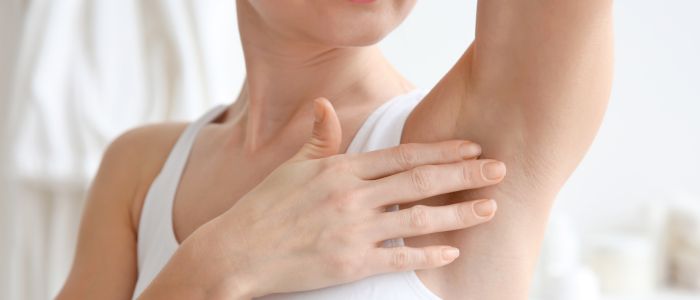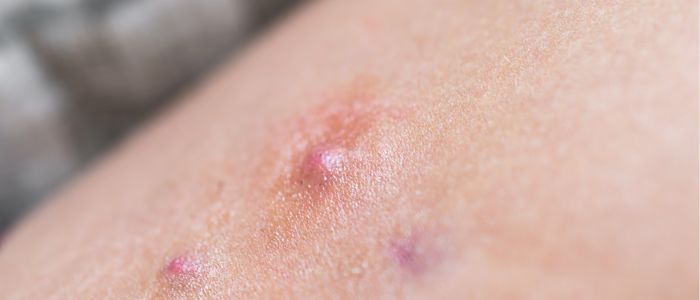
Solutions for Hidradenitis Suppurativa
Living with Hidradenitis Suppurativa (HS) can be a challenging and often frustrating experience. If you’re struggling with this chronic skin condition, you’re not alone. HS affects approximately 1-4% of the global population, yet it remains a frequently misunderstood and underdiagnosed ailment.
Dr Dalia, a dermatologist specialising in skin conditions, can help you understand Hidradenitis Suppurativa better and explore the various treatment options available to manage your symptoms.
What is Hidradenitis Suppurativa?
Hidradenitis suppurativa, often abbreviated as HS, is a chronic inflammatory skin condition that affects the hair follicles in areas where skin rubs together. If you’re dealing with HS, you might experience painful, swollen lumps or boils in specific parts of your body.
Hidradenitis Suppurativa typically develops in areas rich in apocrine sweat glands, such as:
- Armpits (axillae)
- Groin and genital area
- Under the breasts
- Buttocks and anal region
- Inner thighs
- Back of the neck
The condition often begins with the appearance of a single, painful bump that resembles a deep acne cyst or boil. Over time, these bumps can multiply, become more inflamed, and even connect under the skin, forming tunnel-like tracts called sinus tracts.
HS is classified into three stages, known as the Hurley stages:
- Stage I: Single or a few isolated bumps without scar formation or sinus tracts.
- Stage II: Recurrent bumps with scar formation and sinus tract development, but with separated lesions.
- Stage III: Widespread involvement with multiple interconnected sinus tracts and scars across an entire area.
You should know that HS is not contagious, nor is it caused by poor hygiene. It’s a complex condition influenced by many factors.
Causes of Hidradenitis Suppurativa
The exact cause of Hidradenitis Suppurativa isn’t fully understood, but research suggests it results from a combination of genetic, hormonal, and environmental factors. Here are more details about these potential causes:
Genetic Factors
If you have HS, there’s a chance it runs in your family. About one-third of people with HS have a family history of the condition. Researchers have identified several genes that may be associated with HS, including those involved in the immune system and hair follicle development.
Hormonal Influences
Hormones play a role in Hidradenitis Suppurativa development and flare-ups. You might notice that your symptoms worsen around your menstrual cycle or during times of hormonal changes, such as puberty or pregnancy. This is because hormones can affect the function of hair follicles and sweat glands.
Immune System Dysfunction
HS is considered an inflammatory condition, and there’s evidence to suggest that an overactive immune response contributes to its development. Your immune system may be responding inappropriately to bacteria that normally live on your skin, leading to inflammation and the formation of painful lumps.
Lifestyle Factors
While not direct causes, certain lifestyle factors can increase your risk of developing Hidradenitis Suppurativa or exacerbate existing symptoms:
- Smoking: Smokers are at a higher risk of developing HS. The chemicals in cigarettes can irritate hair follicles and alter your immune response.
- Obesity: Excess weight increases friction in skin folds, potentially triggering or worsening HS symptoms.
- Tight clothing: Wearing tight clothes can increase skin friction and trap heat and moisture, potentially aggravating HS.
It’s important to note that while these factors may increase your risk, having one or more of them doesn’t guarantee you’ll develop HS. Conversely, you can develop Hidradenitis Suppurativa without any apparent risk factors.
Common Symptoms and Signs

Recognising the symptoms of Hidradenitis suppurativa is important for early diagnosis and treatment. If you’re concerned you might have Hidradenitis Suppurativa, here are the key signs and symptoms to look out for:
Early Symptoms
- Small, pea-sized lumps: These often appear in areas where skin rubs together, such as the armpits or groin.
- Pain or tenderness: The lumps can be painful, even before they’re visible.
- Itching or heat: You might experience itching or a warm sensation in the affected areas.
As HS progresses, you may notice:
- Recurring bumps: The lumps may heal and reappear in the same or nearby areas.
- Blackheads: You might see small, blackhead-like spots, often appearing in pairs.
- Lesions: These can break open, releasing an unpleasant-smelling discharge.
- Tunnelling: Sinus tracts can form under the skin, connecting separate lesions.
- Scarring: As lesions heal, they may leave rope-like scars.
The impact of HS extends beyond physical symptoms. Many people with HS experience:
- Embarrassment or self-consciousness about their appearance
- Discomfort in social situations
- Difficulties with intimate relationships
- Challenges in certain workplaces or with physical activities
If you’re experiencing any of these symptoms, it’s important to consult a dermatologist like Dr Dalia. Early diagnosis and treatment can help manage symptoms and prevent the condition from progressing to more severe stages.
When to Seek Medical Advice for Hidradenitis Suppurativa
You should consult Dr Dalia if you experience:
- Painful, swollen bumps in areas like your armpits, groin, or under your breasts
- Recurring lumps that heal and reappear in the same areas
- Lesions that don’t heal within a few weeks
- Scars or sinus tracts forming in affected areas
The Diagnostic Process for Hidradenitis Suppurativa
When you visit your dermatologist for a potential HS diagnosis, here’s what you can expect:
- Medical History: Dr Dalia will ask about your symptoms, their duration, and any family history of similar conditions. She’ll also inquire about your overall health, lifestyle, and any medications you’re taking.
- Physical Examination: Your dermatologist will examine the affected areas of your skin, looking for characteristic signs of HS such as nodules, abscesses, sinus tracts, and scarring.
- Staging: If HS is suspected, Dr Dalia will determine the severity of your condition using the Hurley staging system mentioned earlier.
- Skin Cultures: In some cases, she might take a sample of fluid or pus from a lesion to rule out other infections.
- Imaging Tests: In more severe cases, imaging tests like ultrasound or MRI might be used to assess the extent of inflammation and sinus tract formation beneath the skin.
It’s important to note that there’s no specific blood test or single diagnostic test for HS. The diagnosis is typically based on the characteristic appearance of the skin lesions and their location, along with your medical history.
Differential Diagnoses
HS can sometimes be mistaken for other skin conditions. Your dermatologist will consider and rule out conditions such as:
- Ordinary boils or abscesses
- Infected hair follicles (folliculitis)
- Skin cysts
- Sexually transmitted infections
- Crohn’s disease with skin involvement
Treatment Options for Hidradenitis Suppurativa
Managing Hidradenitis suppurativa often requires a combined approach, tailored to your specific symptoms and the severity of your condition. Dr Dalia will guide you through the various treatment options available and help you find the most effective combination for your needs.
Topical Treatments
For mild cases or as part of a more complex treatment plan, topical medications can be beneficial:
- Antiseptic washes: These can help reduce bacterial load on the skin.
- Topical antibiotics: Clindamycin gel or cream may be prescribed to combat infection and reduce inflammation.
- Resorcinol cream: This can help with exfoliation and reducing inflammation.
Oral Medications
When topical treatments aren’t sufficient, oral medications may be recommended:
- Antibiotics: Tetracyclines like doxycycline or minocycline can help control inflammation and fight infection.
- Retinoids: Acitretin may be prescribed to regulate skin cell turnover and reduce inflammation.
- Hormonal therapy: For women, anti-androgen medications or combined oral contraceptives might be beneficial.
- Pain management: Over-the-counter pain relievers can help manage discomfort associated with HS.
Surgical Interventions
In more severe cases or for persistent troublesome lesions, surgical options may be necessary:
- Incision and drainage: This provides immediate relief for painful, pus-filled lesions but doesn’t prevent recurrence.
- Deroofing: This technique involves removing the ‘roof’ of a sinus tract, allowing it to heal from the inside out.
- Wide excision: For severe, recurring lesions, surgical removal of the affected skin may be recommended.
Laser Treatments
Newer approaches using laser therapy show promise in managing HS:
- Nd:YAG laser: This can target hair follicles and reduce inflammation.
- CO2 laser: This may be used for cutting and vaporising sinus tracts.
It’s important to remember that what works best can vary from person to person. Dr Dalia will work with you to find the most effective treatment plan for you, which may involve a combination of these approaches. Regular follow-ups will allow her to monitor your progress and adjust your treatment as needed.
Lifestyle Changes and Self-Care
While medical treatments are essential in managing Hidradenitis Suppurativa, lifestyle modifications and self-care practices can improve your symptoms and overall quality of life. Here are some recommendations:
Dietary Modifications
While there’s no specific “HS diet,” some dietary changes may help reduce inflammation and manage symptoms:
- Anti-inflammatory foods: Incorporate foods rich in omega-3 fatty acids, like salmon and walnuts.
- Low-glycaemic index foods: These may help regulate hormones and reduce inflammation.
- Dairy and yeast: Some people find that reducing or eliminating these foods helps their symptoms.
- Zinc-rich foods: Zinc may help with wound healing and reducing inflammation.
Weight Management
Maintaining a healthy weight can help reduce friction in skin folds and potentially decrease HS symptoms:
- Regular exercise: Choose low-impact activities that don’t irritate affected areas.
- Balanced diet: Focus on whole foods, lean proteins, and plenty of fruits and vegetables.
Smoking Cessation
If you smoke, quitting can significantly improve your HS symptoms:
- Seek support: Consider nicotine replacement therapy or smoking cessation programmes.
- Gradual reduction: If quitting outright is challenging, try to reduce your smoking gradually.
Stress Reduction Techniques
Stress can trigger HS flare-ups, so managing stress is important:
- Mindfulness meditation: This can help reduce stress and improve overall well-being.
- Regular exercise: Physical activity can help manage stress and improve mood.
- Adequate sleep: Aim for 7-9 hours of quality sleep each night.
Proper Hygiene Practices
While HS isn’t caused by poor hygiene, good skincare can help manage symptoms:
- Gentle cleansing: Use mild, antibacterial soap to keep affected areas clean.
- Avoid irritants: Choose fragrance-free, hypoallergenic products.
- Loose-fitting clothing: This can help reduce friction and allow your skin to breathe.
Wound Care
Proper care of HS lesions can promote healing and prevent complications:
- Keep the area clean and dry
- Use appropriate dressings as recommended by your dermatologist
- Avoid squeezing or popping lesions, as this can lead to further inflammation and potential scarring
Keep in mind that these lifestyle changes are not a substitute for medical treatment but rather a complement to it. Every person with HS is unique, so you may need to experiment to find what works best for you.
FAQs about Causes and Treatment for Hidradenitis Suppurativa

Can pregnancy affect Hidradenitis Suppurativa?
- Pregnancy can have varied effects on HS. Some women experience improvement in their symptoms during pregnancy, possibly due to hormonal changes. However, others may find their symptoms worsen. It’s important to discuss your HS management plan with both your dermatologist and obstetrician if you’re pregnant or planning to become pregnant, as some HS treatments may not be suitable during pregnancy.
Is there a connection between Hidradenitis suppurativa and other autoimmune conditions?
- Yes, there appears to be an association between HS and certain autoimmune conditions. People with HS have a higher likelihood of developing conditions such as inflammatory bowel disease (particularly Crohn’s disease), psoriasis, and arthritis. If you have HS, it’s important to be aware of symptoms related to these conditions and discuss any concerns with your healthcare provider.
Can children develop Hidradenitis Suppurativa?
- While HS typically begins after puberty, it can occasionally occur in children, even before puberty. Paediatric HS is rare but can be particularly challenging to manage. If you notice symptoms in your child, make sure to consult a dermatologist experienced in treating HS in younger patients.
How does Hidradenitis Suppurativa affect tattoos?
- If you have tattoos in areas prone to HS lesions, the condition can potentially distort or damage the tattoo. Conversely, getting a tattoo in an area affected by HS can be risky, as it may trigger a flare-up or complicate existing lesions. If you’re considering a tattoo, discuss it with your dermatologist first, and avoid tattooing over active HS lesions or severely scarred areas.
Are there any alternative or complementary therapies that can help manage Hidradenitis Suppurativa?
- While scientific evidence is limited, some people with HS report benefits from complementary therapies such as acupuncture for pain management, or the use of natural anti-inflammatory supplements like turmeric. Hypnotherapy and cognitive behavioural therapy may help manage the psychological impact of the condition. Always consult with your dermatologist before starting any alternative treatments to ensure they won’t interfere with your current HS management plan.
Further Reading about Procedures at Cheshire Cosmetic Surgery
- Read more about Causes and Treatments for Skin Rashes
- Read more about Causes and Treatment for Urticaria
- Read more about Causes and Treatment for Rosacea
- Read more about Causes and Treatment for Psoriasis
- Read more about Causes and Treatment for Melasma
Medical References for Hidradenitis Suppurativa
- Hidradenitis suppurativa – Symptoms and causes
- Prevalence of Hidradenitis Suppurativa – PMC
- Hidradenitis suppurativa (HS) – NHS
- Hidradenitis suppurativa: Causes – American Academy of Dermatology
- Hidradenitis Suppurativa (HS) Smell: What to Know – Verywell Health






